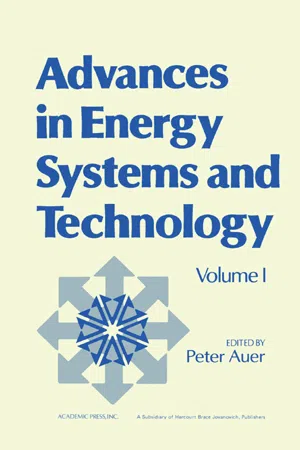I INTRODUCTION AND BACKGROUND
The development of wind power has been characterized generally by periods of progress and longer periods of neglect, but nevertheless the employment of wind power has never been absent from the time of its inception many centuries ago in ancient Babylon and the Middle East, and possibly before that to a suggested genesis from the prayer mills of Tibet. It is convenient, if an oversimplification, to date the modern era from the time of World War I, when powered flight led to the burgeoning of the science of aerodynamics and its adaptation to the development of fluid machines in general. Application of propeller theory to wind turbines by Betz, Glauert, and others still furnishes the basis of modern analysis.
The 25 years from the end of World War II have seen increased, although sporadic, interest in the western countries, of which Denmark, Germany, France, Great Britain, and the United States may be perceived to have made major contributions.
In Denmark, following the earlier pioneering work of La Cour at Askov, particularly in the use of wind power for electricity generation, the concept of wind power for making a significant impact was energetically revived. The complete absence of fossil fuels and the vicissitudes of two world wars led to a not-too-common united effort of government, industry, and public utility to carry out experimental work and to finance, design, operate, and test a number of wind energy conversion systems (WECS), culminating in the Gedser Mill of 200 kW placed in continuous operation in 1958 (Juul, 1956, 1964). Danish activity died down in 1967 after the Gedser Mill suffered a mechanical breakdown after 10 years use, and an adverse economic survey led to the conclusion that wind power was not competitive and the mill was idle for 10 years. However, the current energy shortage has revived interest and recommendations have been made to the government for a five-year, $9,000,000 program in experiment and pilot operation (Hinrichsen and Cawood, 1976; Danish Academy of Technical Sciences, 1975). The Gedser Mill itself was re-commissioned in 1977 for further experimental work, particularly more detailed measurements of the rotor performance (Merriam, 1977–1978). A 2-MW wind turbine has been designed, built, and placed in operation at Tvind by a local community headed by a school group, with consultant help (see Section XII).
In Germany the tradition of Betz (see Section II) has been carried on with Hütter as the major contributor. His work covers many years and stands out, along with that of Juul in Denmark, as having a wide scope in all areas: analysis, design, construction, testing, operation, and economics (Hütter, 1964a, 1977). His name is associated with the Allgaier units produced commercially for many years and with the design of the ERDA-NASA 100-kW MOD-O test unit at Plum Brook, United States. He has also pioneered in the use of composite materials for rotor blades.
French work for the period in question includes that of Lacroix (1969) and Vadot (1957), plus the manufacture and testing of two large units. One, the plant at Nogent-Le-Roi, was rated at 800 kW at a wind speed of 16.7 m/sec (≈37 mph), and this appears to the third largest output wind turbine yet operated. However, the blade diameter was only 30.2 m (≈ 100 ft) owing to the high wind speed for the rated output. The se...
